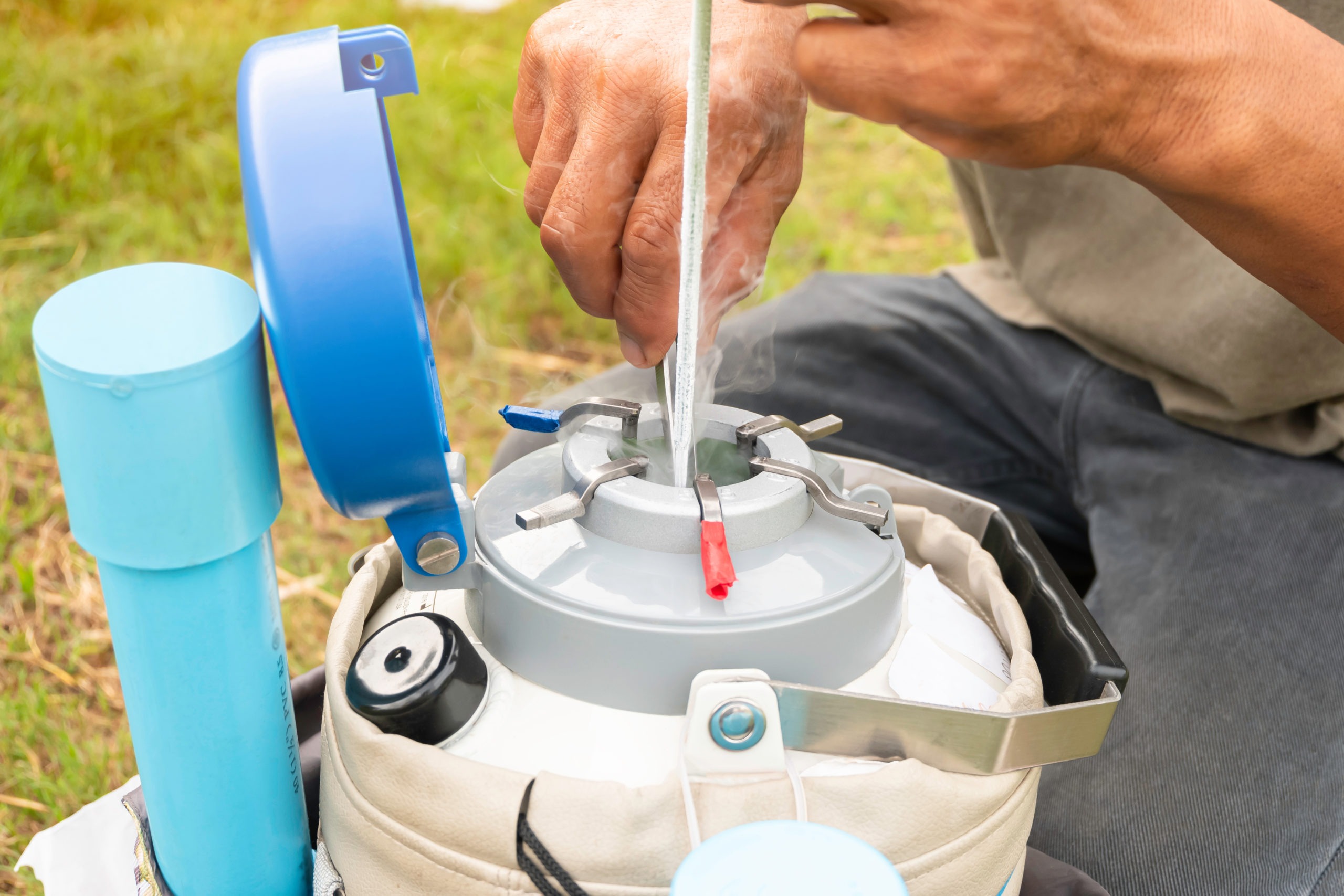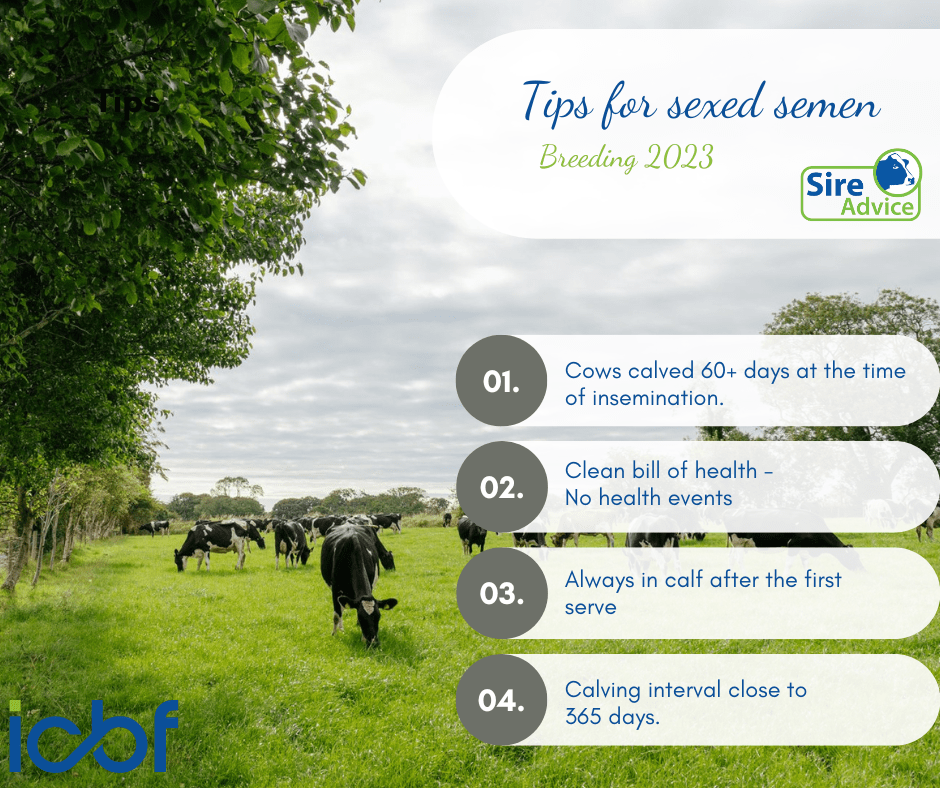The latest analysis undertaken by ICBF, Teagasc and the partner AI companies (i.e., Dovea Genetics, Eurogene/AI Services, Munster Bovine and Progressive Genetics) has indicated that the overall pregnancy rate for sexed semen on Irish dairy farms is now at 59%, compared with conventional AI at 64%. This indicates a relative pregnancy rate for sexed semen of 92% (i.e., sexed semen 92% as good as conventional semen).
This is a significant improvement from the previous studies of sexed semen performance undertaken on Irish dairy farms (in 2013, 2018 and 2019), which had all indicated that the relative pregnancy rate for sexed semen was approximately 84% of that achieved with conventional semen. It should be noted, however, that each of these former studies were based on structured field trial data, whereas the current analysis is based on a statistical analysis of commercial field data.
While the results from the current analysis were positive, they also highlighted the need for strict adherence to the protocols associated with the use of sexed semen. The product will deliver good fertility performance, but only when used on heifers and/or dairy cows that are suitable for breeding (i.e., in good body condition, with sufficient days calved etc.) and after strict adherence to all handling/AI protocols are observed.
The analysis was based on over 1.82m conventional inseminations and 86k sexed semen inseminations completed over a 5 year period (2018 to 2022) and is the most comprehensive analysis of the performance of sexed semen in a commercial field setting ever undertaken.
All inseminations were completed by AI technicians from the partner AI companies, and pregnancy outcomes were validated against a subsequent birth event. No DIY AI inseminations were included in the analysis.
Statistical analyses were undertaken of the field data, with important factors such as year, herd, parity, days in milk and cow genetic merit all accounted for in the model. Results from the study are summarized in Table 1 below.
Table 1. Summary of the performance of sexed versus conventional semen on Irish dairy farms.
| Year of insemination | Semen Type | Records | Pregnancy Rate* | Relative Performance |
| 2018-2022 | Conventional AI | 1,826,910 | 64% | |
| Sexed semen | 85,645 | 59% | 92% | |
| 2022 only | Conventional AI | 335,849 | 63% | |
| Sexed semen | 38,465 | 60% | 95% |
* Pregnancy rate defined as an insemination event that resulted in a subsequent birth event.
The results indicate that the relative performance over the 5 years was 92%, with incremental improvements in the technology also evident based on 2022 inseminations only (at 95% relative performance). Indeed, this positive time trend is evident within the overall dataset, which highlights the ongoing improvements that there has been in the technology over the past 5 years. These include; (i) improvements in the technology (i.e., sexed ultra); (ii) increases in the sperm concentration per straw (most straws now contain 4m sperm cells); and (iii) the establishment of two dedicated sexed semen labs here in Ireland, which has helped ensure greater uniformity of the sexed semen product and markedly increased the number of high EBI bulls available.
Another important outcome from the analysis was that when the raw phenotypic pregnancy rate was compared, then there was no difference in the pregnancy rates achieved by the sexed semen product compared with conventional AI (i.e., both had the same pregnancy rate).This occurred because sexed semen is being used selectively on heifers and the best fertility cows, with adherence to the strict protocols being promoted by Teagasc and the partner AI companies. As a result, the phenotypic pregnancy rates for the sexed semen is biased upwards, with this bias then getting accounted for in the subsequent statistical analysis.
Commenting on the analysis, Dr Stephen Butler, Teagasc noted that the results were an important outcome for dairy farmers using (or planning to use) the sexed semen product this Spring. “In the past, the relative performance of sexed semen compared to conventional was seen as a big barrier to its potential usage by Irish farmers. The fact that the relative performance is now 92% and improving, should hopefully encourage more dairy farmers to consider using the product in their breeding programs this Spring”.
Dr Margaret Kelleher, ICBF (who undertook the overall analysis), noted that the analysis had once again highlighted the significant herd-to-herd variation in the performance of the technology. “Like 2013, the difference in herd performance was striking with the top 10% and bottom 10% of herds achieving pregnancy rates for sexed semen of 73% and 40% respectively, with an average of 59%”. She encouraged herd-owners to use the new sexed semen option as part of the ICBF HerdPlus sire advice tool, as this would make the job of selecting suitable cows and the subsequent breeding of the overall herd much easier from a herd-owner perspective. 
Commenting on the results, Dr Bernard Eivers, NCBC, echoed the comments of Stephen and Margaret, noting that while the results were positive, it was critical that dairy farmers do not get complacent about the technology. “Yes, the results are good, but as an industry, we need to continue to ensure that the technology gets applied correctly on farms, otherwise there will be disappointments” That said, he encouraged those dairy farmers that have not yet tried the technology to consider it this breeding season. “Our experience is that dairy farmers starting with the technology generally will try 10-15 straws, depending on their herd size and we would encourage more farmers to adopt this approach this breeding season”
Dr Andrew Cromie, GM for Sexing Technologies Europe thanked Margaret, Stephen and the partner AI companies for undertaking the seminal piece of work; “It is a fantastic endorsement of the collaborative nature of the Irish cattle breeding industry, that this sort of comprehensive analysis, incorporating almost 2m insemination records, could be undertaken. The fact that dairy farmers can now have access to a technology that will help them address future challenges regarding dairy male calves, including also carbon inventories, is a significant step forward.”
He looked forward to continuing to work with ICBF, Teagasc and the partner AI companies in the further roll-out of the technology across more dairy (and beef) farms in the future, including also the future opportunities to look at fresh sexed dairy semen and sexed beef semen.


